No CrossRef data available.
Article contents
Raw data + analysis code > descriptive statistics
Published online by Cambridge University Press: 14 December 2021
Abstract
An abstract is not available for this content so a preview has been provided. Please use the Get access link above for information on how to access this content.

- Type
- Commentaries
- Information
- Copyright
- © The Author(s), 2021. Published by Cambridge University Press on behalf of the Society for Industrial and Organizational Psychology
Footnotes
Cort W. Rudolph, Department of Psychology, Saint Louis University, St. Louis, MO (USA). Hannes Zacher, Institute of Psychology–Wilhelm Wundt, Leipzig University, Leipzig, Germany.
References
Bishop, D. (2015, December 15). Who’s afraid of open data: Scientists’ objections to data sharing don’t stand up to scrutiny. LSE Impact Blog. https://blogs.lse.ac.uk/impactofsocialsciences/2015/12/16/whos-afraid-of-open-data-dorothy-bishop/
Google Scholar
Curran, P. J., & Hussong, A. M. (2009). Integrative data analysis: The simultaneous analysis of multiple data sets. Psychological Methods, 14(2), 81–100. https://doi.org/10.1037/a0015914
CrossRefGoogle ScholarPubMed
Eisenhauer, J. G. (2021). Meta-analysis and mega-analysis: Asimple introduction. Teaching Statistics, 43(1), 21–27. https://doi.org/10.1111/test.12242
CrossRefGoogle Scholar
Hunter, J. E., & Schmidt, F. L. (2004). Methods of meta-analysis: Correcting error and bias in research findings. SAGE.10.4135/9781412985031CrossRefGoogle Scholar
Katz, I. M., Rudolph, C. W., & Zacher, H. (2019). Age and career commitment: Meta-analytic tests of competing linear versus curvilinear relationships. Journal of Vocational Behavior, 112, 396–416. https://doi.org/10.1016/j.jvb.2019.03.001
CrossRefGoogle Scholar
Laine, H. (2017). Afraid of scooping–case study on researcher strategies against fear of scooping in the context of open science. Data Science Journal, 16, 29. http://doi.org/10.5334/dsj-2017-029
CrossRefGoogle Scholar
Levelt, P., Noort, E., & Drenth, P. (2012). Flawed science: The fraudulent research practices of social psychologist Diederik Stapel. Tilburg University. https://www.rug.nl/about-ug/latest-news/news/archief2012/nieuwsberichten/stapel-eindrapport-eng.pdf
Google Scholar
Murphy, K. (2021). In praise of Table 1: The importance of making better use of descriptive statistics. Industrial and Organizational Psychology: Perspectives on Science and Practice, 14(4), 461–477.Google Scholar
Nowok, B., Raab, G. M., & Dibben, C. (2016). synthpop: Bespoke creation of synthetic data in R. Journal of Statistical Software, 74(11), 1–26. https://doi.org/10.18637/jss.v074.i11
CrossRefGoogle Scholar
Poldrack, R. A., & Poline, J. B. (2015). The publication and reproducibility challenges of shared data. Trends in Cognitive Sciences, 19(2), 59–61. https://doi.org/10.1016/j.tics.2014.11.008
CrossRefGoogle ScholarPubMed
Rudolph, C., & Jundt, D. (2017, July 18). Why betas should not rule metas. PsyArXiv. https://doi.org/10.31234/osf.io/jacdy
CrossRefGoogle Scholar
Rudolph, C. W. (2021). Improving careers science: Ten recommendations to enhance the credibility of vocational behavior research. Journal of Vocational Behavior, 126, Article 103560. https://doi.org/10.1016/j.jvb.2021.103560
CrossRefGoogle Scholar
Schmidt, F., & Hunter, J. (2002). Are there benefits from NHST? American Psychologist, 57(1), 65–66. https://doi.org/10.1037/0003-066X.57.1.65
CrossRefGoogle ScholarPubMed
Silberzahn, R., Simonsohn, U., & Uhlmann, E. L. (2014). Matched-names analysis reveals no evidence of name-meaning effects: Acollaborative commentary on Silberzahn and Uhlmann (2013). Psychological Science, 25(7), 1504–1505. https://doi.org/10.1177/0956797614533802
CrossRefGoogle Scholar
Simonsohn, U. (2013). Just post it: The lesson from two cases of fabricated data detected by statistics alone. Psychological Science, 24(10), 1875–1888. https://doi.org/10.1177/0956797613480366
CrossRefGoogle ScholarPubMed




